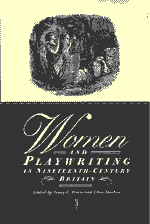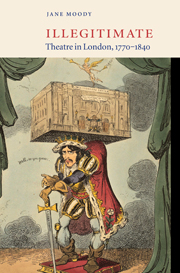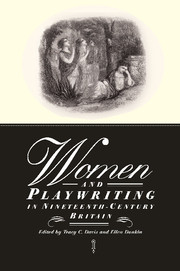The Economics of the British Stage 1800–1914
$63.99 (C)
- Author: Tracy C. Davis, Northwestern University, Illinois
- Date Published: June 2007
- availability: Available
- format: Paperback
- isbn: 9780521036856
$
63.99
(C)
Paperback
Other available formats:
Hardback
Looking for an examination copy?
This title is not currently available for examination. However, if you are interested in the title for your course we can consider offering an examination copy. To register your interest please contact [email protected] providing details of the course you are teaching.
-
British theater became big business in the nineteenth century, and the role of laissez-faire in this cultural industry consistently troubled the government. This is the first full-length study to investigate the theater's growth from an economic perspective, reflecting the debates of theorists from Adam Smith to Alfred Marshall. Tracy Davis' wide-ranging analysis grounds issues such as subsidization and the economic viability of the live arts in an era predating government funding, offering fresh insight into the history of cultural policy for the arts in Britain.
Read more- A comprehensive study of economic theory in relation to nineteenth-century British theatre
- Broad interdisciplinary appeal - theatre, social history, economics, sociology of culture, gender studies
- Provides an alternate perspective on the history of cultural policy for the arts in Britain
Awards
- Winner of the George Freedley Memorial Award 2001, presented by the Theatre Library Association
Reviews & endorsements
"[A]n immensely accomplished work of theatre history." Essays in Theatre
See more reviews"Copious, precise, and palpable, Davis's scholarly labors--the scene of her writing--become the scrim through which to encounter the economic conditions in which British theatre was produced between the years 1800 and 1914." Theatre Journal
"This book will appeal to historians of the theater and of media studies; its focus on the theater as an industry adds a new dimension. The author brings very useful statistics to illuminate the study of costs. The book will also make fascinating reading for social and cultural historians." EH.NET
Customer reviews
Not yet reviewed
Be the first to review
Review was not posted due to profanity
×Product details
- Date Published: June 2007
- format: Paperback
- isbn: 9780521036856
- length: 528 pages
- dimensions: 229 x 153 x 30 mm
- weight: 0.786kg
- contains: 17 b/w illus. 29 tables
- availability: Available
Table of Contents
List of illustrations
List of figures
Acknowledgements
Abbreviations
Note to readers
Introduction
Part I. Competition: Theatre and Laissez-Faire:
1. Monopoly and free trade: fair and unfair competition
2. Property and the stakes of private interest
3. Industrial regulation and safety
4. Marginal economics, national interest and the half-naked woman
Part II. Ownership and Entrepreneurialism:
5. Opportunity, finance and failure
6. Profit
7. Business structures
8. Gender, 'gentlemanly capitalism' and the wo-manager
Part III. Industrialization, Commodity Capitalism and Theatre Production Systems:
9. Labour and labourers
10. Theatre as cultural capital
Appendix: 'To the public. Charles Kemble's mercies or the '999' increasing'
Notes
Bibliography
Index.
Sorry, this resource is locked
Please register or sign in to request access. If you are having problems accessing these resources please email [email protected]
Register Sign in» Proceed
You are now leaving the Cambridge University Press website. Your eBook purchase and download will be completed by our partner www.ebooks.com. Please see the permission section of the www.ebooks.com catalogue page for details of the print & copy limits on our eBooks.
Continue ×Are you sure you want to delete your account?
This cannot be undone.
Thank you for your feedback which will help us improve our service.
If you requested a response, we will make sure to get back to you shortly.
×








